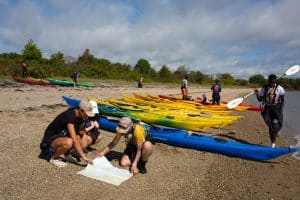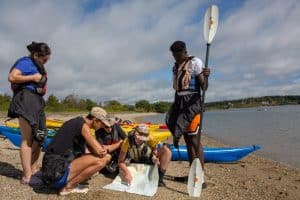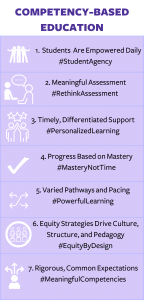Implementation with Integrity
CompetencyWorks Blog
When I first had the idea of the CBE Starter Pack Series, I thought I’d easily write one each week or maybe every other week. But as I got into each one, I (re)discovered just how many important ideas and resources there are for each element. I allowed myself to slow down the pace. At the end of February, the 7th Starter Pack went live on the blog. Phew! As shouldn’t be a surprise to me, I immediately thought of two things:
- Now I can get to all of my other writing projects – like catching up on site-visit blogs, and
- I think I need to write one more framing post for the CBE Starter Pack Series.

Multiple Pathways to Implementation
A key challenge in the ecosystem of learner-centered, personalized, competency-based education (CBE) is that it is not one-size-fits-all for students nor for any single school, district, or state. This framing post explores the implications of this for our work and the possibility that the Aurora CBE Definition – created with considerable field collaboration – could function as a “meta-definition” to organize across different frameworks, models, and taxonomies.
I’ve been thinking a lot about the many, many terms in the field of learner-centered, equity-seeking, and educational transformation.
- Competency-based education, competency-based learning, mastery-based learning, proficiency-based learning, performance-based learning
- Personalized learning, deeper learning, transformational learning
- Learner-centered, student-centered, learner-driven
Sometimes we can reasonably say these are synonyms. Sometimes we may need to unpack our definitions more carefully. Sometimes different terms mean the same thing. Sometimes the same terms mean different things to different people.

A Movement of Movements
I believe that CompetencyWorks, and myself by extension, have a responsibility and role in the field to contribute to a coherent vision and foster our collective commitment to learn, improve, and share. In working collaboratively to figure out the policies and practices that make our vision a reality, we can catalyze a paradigm shift in our education system. The change we are working towards is bigger than any one approach. What can we learn together about what works? How can we frame our efforts as part of a larger movement of movements on behalf of our young people and our shared future?
If we embrace that there is no one right pathway for all, we can shift from the idea of “implementation with fidelity” to “implementation with integrity” – integrity to local communities and contexts and to what we know about how humans learn. For example, how one place cultivates student agency (CBE Definition Element 1) does not have to be the same as how another place does it. However, we can agree that agency is important for student learning based on what we know from the learning sciences.

Designing for equity means more than providing equal resources and creating access to the same system that was designed to maintain the power of “whiteness” by oppressing historically marginalized groups. We must reckon with the fact that our K-12 education system has been shaped by a legacy of institutionalized racism. New innovations and models will contribute to the harm, rather than to a new paradigm if they replicate the same power dynamics. Shifting from a mindset of “one right way” to include different perspectives and ways of being is essential for building a system that works for all students.
If we as a field are committed to creating an anti-racist, non-oppressive system, we must also get curious about the ways our mindsets and practices are influenced by the existing system. When we as organizations act too narrowly from a position of scarcity and competition by implying our model is the only or best approach, we undermine the case for multiple pathways and reinforce “one right way” thinking. Let us connect across different approaches and movements for equity in education. Let us learn and move together while still honoring our unique contributions to our shared effort.
CBE as a “Meta-Definition” for Education Transformation
The CBE Starter Pack series offers an entry point for having deeper conversations about how different approaches address each element of the CBE definition. Where does an approach lean into reinvention and new paradigms? Where does it begin with more incremental change? If we think of implementation as a continuum rather than an all-or-nothing binary, we can better map the inflection points where we shift from incremental tweaking to transformational change. We can look at what combinations of changes in structure, culture, and pedagogy get to a tipping point in which contexts.
If we commit to deepening these conversations and talking about different pathways to our shared goal to deliver on our educational promises to our youth, I see many opportunities for moving our field forward.
- Clarity of Purpose – Speaking coherently about the goals we have for learners is a first step. In Profile of a Graduate work, we often hear that most people want education to cultivate a broader definition of success for students – skills such as creativity, collaboration, critical thinking, problem-solving, self-awareness, goal-setting, and decision-making – that develops healthy, fulfilled humans who continue to learn and are able to thrive and contribute to their communities.
- Understanding of the Change Process – We also need to talk coherently about how we reach these goals for learners. In particular, there are different ways to get to a redesigned system and not a single recipe for how to do the work. Change is messy and hard, but it is the right thing to do. Building on a clear, shared purpose, we can empower the public and our communities to engage in the change process.
- Create Local Process and Use Available Resources – Embracing the need for a change process that happens with integrity to the local context doesn’t mean it is necessary to start from scratch on the details. Adapting the model or the set of practices that fits with the local vision allows communities to build on what others have learned and on the evidence base for what works. Even as we lead with flexibility and multiple pathways, we should also be exploring what scale can look like. Every school system can find its path to transformation.
- Deeper Understanding of Quality – If we can keep our own taxonomies and frameworks but tie them into a shared “meta-definition,” we can create a powerful evidence-based way of talking about what quality implementation and outcomes look like across different contexts.
- Measuring What Matters – To put a shared “meta-definition” into use, we can continue to build on the field’s work to develop implementation metrics. We will be poised to build a body of research to support and assess the readiness, implementation, and efficacy of the array of CBE approaches. We can expand the evidence base to show a) how the implementation is happening, and b) what learner-centered outcomes are resulting. We can explore new methods for how we study school transformation that unfold within a local context on multiple complex dimensions.
A Change Process Grounded in Implementation with Integrity
While different approaches vary in the details, a sustainable change process starts with listening to and engaging with people in a community. This is where implementation with integrity starts. Grounded in shared understanding and a shared vision for educating the children in the community, leaders then guide the work and continue to seek input and dialogue with the community.
There is no need to start from scratch on the practices and systems that build towards the locally grounded vision. Leaders and their communities can adopt and adapt aligned practices, policies, and systems to fit their needs. Grounding in the CBE definition or another “meta-definition” can ensure that those choices align with what we know about what supports learning without creating an illusion that there is one best approach. If we as a field can support communities in engaging in this kind of ongoing, iterative process to chart their own pathway to a future-focused, equitable education system, we can catalyze scalable progress toward education transformation.
The CBE Starter Pack aims to be one resource for navigating the pathways to implementation. CompetencyWorks will continue to tell the stories of implementation. We will continue to bring people together to share and develop breakthrough practices and policies that help build the confidence of communities to implement with integrity.
Read the Starter Pack Series
- CBE Starter Pack 1: Students are Empowered Daily
- CBE Starter Pack 2: Meaningful Assessment
- CBE Starter Pack 3: Timely, Differentiated Support
- CBE Starter Pack 4: Progress Based on Mastery
- CBE Starter Pack 5: Learn Actively With Varied Pathways and Pacing
- CBE Starter Pack 6: Equity Strategies Drive Culture, Structures, and Pedagogy
- CBE Starter Pack 7: Establish Rigorous, Common Expectations with Meaningful Competencies
Laurie Gagnon is the Aurora Institute’s CompetencyWorks Program Director. She has been thinking about implementation with integrity for awhile in her work to support educators and learners in designing performance assessments and competency-based systems both at the Center for Collaborative Education and reDesign. Laurie is humbled by and grateful for the opportunity to share her ideas through CompetencyWorks.
